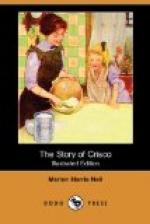[Illustration]
There are five principal ways of making cakes.
The first method is used for plain cakes. The shortening is rubbed into the flour in the same way as for short pastry; then the dry ingredients, such as sugar, fruit, and spice, are added, and lastly the eggs and milk. Then all are mixed well together.
The second way is used for fruit, pound, and seed cakes. The shortening and sugar are creamed together, the eggs beaten in one at a time, and the fruit and flour stirred in lightly and quickly at the last.
In the third way the eggs and sugar are beaten together until thick and creamy, then the flour is stirred in lightly and quickly. This is used chiefly for sponge cakes and cakes of that texture.
For the fourth way the sugar, shortening, milk, and syrup or molasses are melted together, then cooled slightly and added to the dry ingredients. This method is used for ginger-breads.
In the fifth way the sugar and eggs are beaten thoroughly over boiling water, then cooled before the melted shortening and dry ingredients are added. This method is used for Gennoise cake and some kinds of layer cakes. Care must be taken to insure the right consistency of cakes. The mixture should be fairly stiff. If too moist the fruit will sink to the bottom. For rich cakes the tins should be lined with paper, the paper coming a short distance above the tins, so that the cake is protected as it rises. For very rich fruit cakes, experience has shown that it is best not to grease the paper or tin. The cake is not so liable to burn, and the paper can be removed easily when the cake is done without injuring it. On the other hand, if tins are lined for sponge cakes or jelly-rolls, the paper should be greased.
[Illustration]
When making cakes in which baking powder, carbonate of soda, cream of tartar or tartaric acid are used, almost everything depends upon the handling, which should be as light and as little as possible. The more rapidly such cakes are made the better they will be. Two cooks working from the same recipe will often produce entirely different results, if one kneads her mixture as if it were household bread, while the other handles it with due lightness of touch. As soon as the baking powder or other rising medium is added to the mixture, the cake should be put into the oven as quickly as possible. Soda alone is never good in a cake where there is shortening, unless some substance containing acid is used along with it. Molasses is one of the substances containing acid.
The greatest care and cleanliness must be exercised in all cake making; and accuracy in proportioning the materials to be used is indispensable. The flour should be thoroughly dried and sifted, and lightly stirred in. Always sift flour before measuring, then sift it again with the baking powder to insure a thorough blending.




